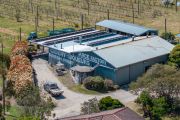
Getting ahead of the curve to pull building industry higher
If you’re planning a building you now must ask: How much waste will it generate in construction and how much of that can be recycled? And if you want a high Green Star rating – increasingly required as investors focus on lower-carbon assets – you’ll need to know the answer.
But this comes as no surprise. The tightening of circularity requirements in construction due in an updated Green Star Buildings standard has been a topic of consultation in the industry since last year. So have other critical changes such as mandating all-electric buildings and tightening energy consumption benchmarks.
This is the strategy of the Green Building Council of Australia, which aims to reform property practices in a world where buildings account for as much as 28 per cent of global carbon emissions from operation and 11 per cent of the global total from materials and construction.

The Green Building Council of Australia won the property and construction category of this year’s Financial Review Sustainability Leaders list for its strategy.
“We wanted to be able to set up a vision for industry that was longer-term – not just an update of the standard by surprise – by being able to tell them the journey we were expecting industry to go through,” says Green Building Council of Australia chief impact officer Jorge Chapa.
“Once we had the strategic certainty we had big buy-in from industry.”
They achieved that with Green Star Future Focus, the process the organisation adopted in 2018 to take industry along as it lifted standards required to secure the star ratings that investors and tenants increasingly pay attention to.
Registration of projects subjecting themselves to measurement under the Green Star Buildings standard has been faster since it was released in 2020 than for the 2014 Green Star Design & As Built standard, which it has superseded for new buildings. Five years after their respective releases, the newer standard has twice the registrations.
“We smashed the same numbers,” Chapa says. “We have increased the amount of registrations on a comparative basis since the last update in 2014 and this update.”
The standards also needed an overhaul. In 2014, the council came under fire from founders Maria Atkinson and Ché Wall, who said it was at risk of watering down the rating tool to allow more buildings to be certified.
Chapa says the Green Star Design & As Built standard allowed broader market acceptance of the rating tool “across more project types, while holding firm on sustainability outcomes”. But he says the council also then tightened its standards.
“When we released Green Star Buildings in 2020, we were in a stronger position to raise the bar again,” he says. “We rewrote 80 per cent of the tool from scratch to reflect contemporary best practice and align with net-zero and resilience goals.”
It’s also mended ties with Atkinson and Wall, he says.
“We’ve since built close relationships with our co-founders – both Maria and Ché were front and centre at our 20th anniversary,” Chapa says. “Green Star Buildings has been well received, including formal recognition by the Climate Bonds Initiative – an achievement Ché Wall helped drive.”
The race to a more sustainable future chases a horizon that keeps moving – necessarily so, as reducing carbon emissions is a constantly evolving game.
The use of gas in commercial buildings is an example. To secure a 6-star rating in 2020, a new building had to be all-electric, with no gas connection, but upgrades to the standards made no gas connection and being all-electric a basic requirement of securing a 5-star rating for a new building in 2023.
From January 1 this year, it became a basic requirement for a 4-star rating in a new commercial building.
Similar changes are taking place in residential construction, where the use of gas is being phased out and a greater focus on thermal efficiency – by better design to make use of sunlight, better insulation and double-glazing – is reducing operational carbon emissions.
A greater focus on embodied carbon use in housing construction will increasingly scrutinise the materials and components going into a home in Australia, following steps already taken in countries such as the UK and Denmark.
The threshold for recycling starts at 80 per cent of waste on a site and the rating tool awards additional credits to projects achieving a rate 90 per cent or higher.
As a result, the council is already laying out for investors and developers the requirements to reduce waste created on-site in the next version of the tool, due to be released before the end of the year.
“What’s new in v1.1 is the introduction of requirements to also reduce the total amount of waste generated on site – not just how much is recycled,” Chapa says.
“Recycling 90 per cent of a large amount of waste is great. To recycle 90 per cent of a smaller amount of waste is even better.”
That will help drive the adoption of so-called modern methods of construction – such as modular and prefabrication – which produce components in a factory and assemble them on site, replacing traditional building processes. These also reduce embodied carbon, Chapa says.
“Circular thinking is driving an outcome that is not just taking care of the tail end of a problem but hitting the front end of a problem,” he says.
“We would expect the rating tools to start driving those outcomes.”











